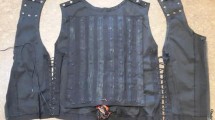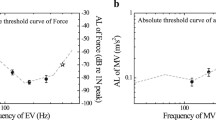Abstract
High-frequency vibrations are an essential part of numerous manipulation tasks. A promising research area, in particular, are telemanipulation tasks where vibrations occurring in the remote environment are fed back through tactile displays. Three experiments concerning the perception of vibrations were conducted. The first experiment aims at determining whether vibrations are coded primarily by frequency, amplitude, or acceleration by human participants. Results show that primarily frequency and amplitude, but not acceleration of the vibrations were perceived. In the second experiment, participants’ just noticeable difference (JND) for frequency under different conditions was examined. The resulting JND of 18% for frequencies showed dependence neither on the amplitude or acceleration, which were independently held constant, nor on the reference frequencies. Therefore, it is not necessary to adjust the subjective intensity for vibrations for each human operator when designing and using tactile displays. In the third experiment, the stimuli and the procedure of the second experiment were replicated using different configurations and a mere force-output device. The resulting JNDs were 21% for vibrations of 100 Hz, and 17% for vibrations of 150 Hz and above. Furthermore, there was no visual dominance over the haptic modality regarding the JND for frequencies.
Similar content being viewed by others
References
Dennerlein, J.T., Millman, P.A., Howe, R.D.: Vibrotactile feedback for industrial telemanipulators. In: Proceedings of the ASME Dynamic Control Division, Dallas, pp. 189–195 (1997)
Okamura, A.M., Dennerlein, J.T., Howe, R.D.: Vibration feedback models for virtual environments. In: Proceedings of the 1998 IEEE International Conference on Robotics and Automation, Leuven, pp. 674–679 (1998)
Hollins M. (2002). Touch and haptics. In: Yantis, S. and Pashler, H. (eds) Steven’s handbook of experimental psychology, Vol. 1: Sensation and perception, pp 585–618. Wiley, New York
Moy, G., Wagner, C., Fearing, R.S.: A compliant tactile display for teleaction. In: Proceedings of the 2000 IEEE International Conference on Robotics & Automation, Piscataway, pp. 3409–3415 (2000)
Allam, H.M.: Single element based tactile display. In: Proceedings of the 2004 International Workshop on Robot Sensing, Piscataway, pp. 49–54 (2004)
Kontarinis D.A. and Howe R.D. (1995). Tactile display of vibratory information in teleoperation and virtual environments. Presence 4(4): 387–402
Bolanowski S.J. Jr., Gescheider G.A., Verrillo R.T., Checkosky C.M. (1988) Four channels mediate the mechanical aspects of touch. J. Acoust. Soc. Am. 84(5): 1680–1694
Johnson K. (2002). Neural basis of haptic perception. In: Yantis, S. and Pashler, H. (eds) Stevens’ handbook of experimental psychology, Vol. 1: Sensation and perception., pp 537–583. Wiley, New York
Lederman S.J. and Klatzky R.L. (1999). Sensing and displaying spatially distributed fingertip forces in haptic interfaces for teleoperator and virtual environment systems. Presence 8(1): 86–103
Hollins M., Bensmaïa S.J. and Roy E.A. (2002). Vibrotaction and texture perception. Behav. Brain Res. 135: 51–56
Klatzky R.L. and Lederman S.J. (1999). Tactile roughness with a rigid link interposed between skin and surface. Percept. Psychophys. 61(4): 591–607
Pawluk D. and Howe R. (1996). A holistic model of human touch. In: Bower, J.M. (eds) Computational neuroscience trends in research, pp 759–764. Plenum, New York
Seow K.C. (1988). Physiology of touch, grip and gait. In: Webster, J.G. (eds) Tactile sensing for robotics and medicine, pp 13–40. Wiley, New York
Burdea G.C. (1996). Force and Touch Feedback for Virtual Reality. Wiley, New York
Schmidt R.F.: Somato-viscerale Sensibilität. In: Schmidt R.F., (eds.) Grundriß der Sinnesphysiologie. Springer, Berlin, pp. 42–93 (1973)
Sherrick C.E., Craig J.C. (1982). The psychophysics of touch. In: Schiff W., Foulke E. (eds). Tactual perception: A sourcebook. Cambridge University Press, Cambridge, pp. 55–81
Bensmaïa S.J. and Hollins M. (2000). Complex tactile waveform discrimination. J. Acoust. Soc. Am. 108(3 Pt 1): 1236–1245
Greenspan J.D. and Bolanowski S.J. (1996). The psychophysics of tactile perception and its peripheral physiological basis. In: Kruger, L. (eds) Pain and touch, pp 25–103. Academic, San Diego
Makous J.C., Friedman R.M. and Vierck C.J. Jr. (1995). A critical band filter in touch. The J.Neurosci. 15(4): 2808–2818
Franzén O. and Nordmark J. (1975). Vibrotactile frequency discrimination. Percept. Psychophys. 17(5): 480–484
Goff G.D. (1967). Differential discrimination of frequency of cutaneous mechanical vibration. J. Exp. Psychol. 74(2 Pt 1): 294–299
Rothenberg M., Verrillo R.T., Zahorian S.A., Brachman M.L. and Bolanowski S.J. Jr. (1977). Vibrotactile frequency for encoding a speech parameter. J. Acoust. Soc. Am. 62(4): 1003–1012
Mowbray G.H. and Gebhard J.W. (1957). Sensitivity of the skin to changes in rate of intermittent mechanical stimuli. Science 125: 1297–1298
Craig J.C. (1972). Difference threshold for intensity of tactile stimuli. Percept. Psychophys. 11(2): 150–152
Craig J.C. (1974). Vibrotactile difference thresholds for intensity and the effect of a masking stimulus. Percept. Psychophys. 15(1): 123–127
La Motte R.H. and Mountcastle V.B. (1975). Capacities of humans and monkeys to discriminate between vibratory stimuli of different frequency and amplitude: A correlation between neural events and psychophysical mechanisms. J Neurophysiol. 38: 539–559
Kenshalo D.R. (1986). Somesthetic sensitivity in young and elderly humans. J. Gerontol. 41(6): 732–742
Goble A.K., Collins A.A. and Cholewiak R.W. (1996). Vibrotactile threshold in young and old observers: The effect of spatial summation and the presence of a rigid surround. J. Acoust. Soc. Am. 99(4 Pt 1): 2256–2269
Berglund B., Berglund U. and Ekman G. (1967). Temporal integration of vibrotactile stimulation. Percept. Motor Skills 25: 249–560
Bliss J.C., Crane H.D., Mansfield P.K. and Townsend J.T. (1966). Information available in brief tactile presentations. Percept. Psychophys. 1: 273–283
Sinclair R.J. and Burton H. (1996). Discrimination of vibrotactile frequencies in a delayed pair comparison task. Percept. Psychophys. 58(5): 680–692
Verrillo R.T. (1963). Effect of contactor area on the vibrotactile threshold. J. Acoust. Soc. Am. 35(12): 1962–1966
Klatzky R.L., Lederman S.J. and Langseth S. (2003). Watching a cursor distorts haptically guided reproduction of mouse movement. J. Exp. Psychol. App. 9(4): 228–235
Welch R.B. and Warren D.H. (1986). Intersensory interactions. In: Boff, K.R., Kaufman, L. and Thomas, J.P. (eds) Handbook of Perception and Human Performance, Vol. II: Cognitive Processes and Performance, pp 25-1–25-36. Wiley, New York
Mood A.M., Graybill F.A. and Boes D.C. (1974). Introduction to the theory of statistics. McGraw-Hill, New York
Gescheider, G.A.: Psychophysics, Lawrence Erlbaum (1985)
Brooks, T.L.: Telerobotic response requirements. In: Proceedings of the IEEE International Conference on Systems, Man, and Cybernetics, New York, pp. 113–120 (1990)
Lamoré P.J.J. and Keemink C.J. (1988). Evidence for different types of mechanoreceptors from measurements of the psychophysical threshold for vibrations under different stimulation conditions. J. Acoust. Soc. Am. 83(6): 2339–2351
Author information
Authors and Affiliations
Corresponding author
Rights and permissions
About this article
Cite this article
Pongrac, H. Vibrotactile perception: examining the coding of vibrations and the just noticeable difference under various conditions. Multimedia Systems 13, 297–307 (2008). https://doi.org/10.1007/s00530-007-0105-x
Published:
Issue Date:
DOI: https://doi.org/10.1007/s00530-007-0105-x




